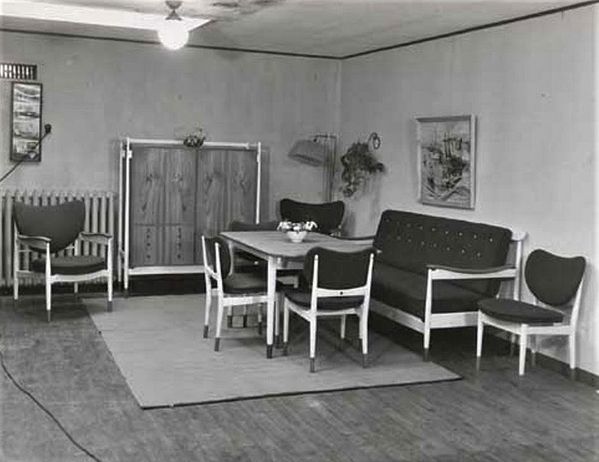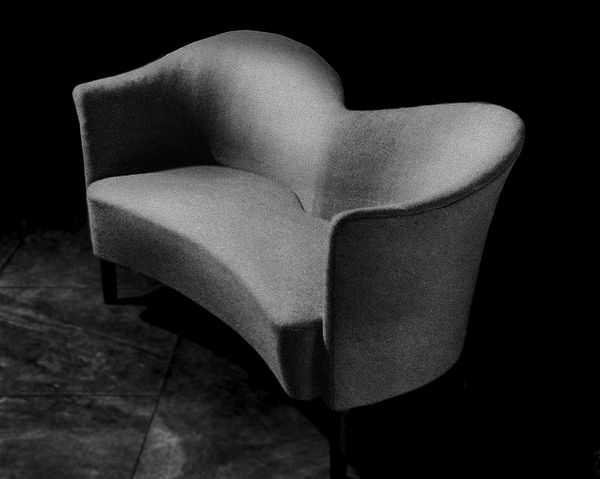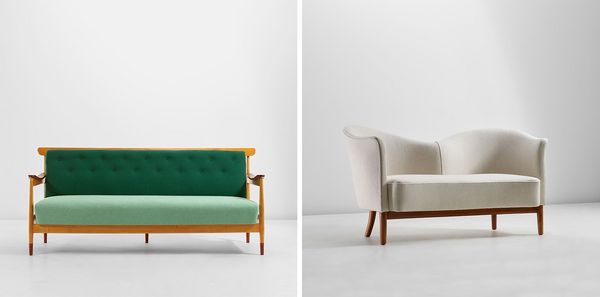Left: Finn Juhl, Rare three-seater sofa, 1949. Design London. Right: Nanna and Jørgen Ditzel, Rare two-seater sofa, 1949. Design London.
Written by Thomas Dickson, architect, industrial Designer and author of Dansk Design
1949 was a very good year for Danish furniture design. Several chairs that are now considered to be classic masterpieces were shown for the first time at the annual Cabinetmakers’ Exhibition in Copenhagen. Hans J. Wegner’s remarkable Round Chair was present, though hardly noticed at first, among all the other artistic and visually striking pieces designed by his many colleagues. Only later did it become his claim to fame. Finn Juhl’s Chieftain Chair was also revealed on this occasion. This huge chair is considered the pinnacle of Juhl’s work within his sculptural design style. It was successfully executed with delicate details and outstanding craftsmanship by master cabinetmaker Niels Vodder.
The present three-seater sofa has many of the same qualities as the Chieftain Chair. It also dates from 1949 but, more importantly, it has similar design and construction features. Juhl was one of the first designers to actively emphasize the separation between the load-bearing framework and the person-bearing seating parts. One can quickly and clearly recognize how the sofa’s refined wooden framework seems to be somewhat detached from the upholstered elements of the seat and backrest. In other words, there is a structural frame, almost like scaffolding, and then there are the soft parts that meet the human body. The sofa is broken down even further into smaller components, at least visually. The seat and backrest are in two different colors, highlighting that they are independent components of the whole design. Similarly, the frame consists of different wood types: the armrests and the bottom parts of the five legs are made of teak, while the rest of the frame is made of maple.
This sofa may be considered slightly more restrained than Finn Juhl’s other furniture, but it has details that point towards his stylistic direction. For example, the front legs don’t go all the way up to support the armrest directly but stop just millimeters below, thus adding to the traditional feeling of lightness and elegance of a Juhl piece. The sofa was made by master cabinetmaker Søren Willadsen, who had a large furniture workshop in the town of Vejen in Southern Jutland. The company was almost the size of a factory but based on traditional craftsmanship and high standards. Several Danish modern designers had some of their pieces made here; alongside Finn Juhl, there were Illum Wikkelsø, Kristian Vedel and, last but not least, Nanna and Jørgen Ditzel.

The rare three-seater sofa was presented at the 39th Købestævnet fair in Fredericia, Denmark, August 1949. Photo: Designmuseum Danmark.
The rare two-seater sofa by the Nanna and Jørgen Ditzel was coincidentally crafted by Søren Willadsen’s son, Knud Willadsen, who had his workshop in Copenhagen. For a couple of years in the late 1940s, Knud had a close collaboration and shared a workshop with Einar Pedersen, the renowned co-founder of PP Furniture, which makes many of Hans Wegner’s most famous chairs today. The Ditzel sofa is also from 1949 but shows quite a different approach to design than the Juhl three-seater. Apart from the stained beech legs, the framework is fully upholstered and disguised by an off-white fabric. This was perhaps an atypical design for the Ditzel couple at the time yet points to some designs that appear in Nanna Ditzel’s later work.

A sofa for intimate conversation. Photo: Nanna Ditzel Design.
This two-seater sofa is evidently meant for human interaction between two people, a seating for intimate conversation. It has a soft and cozy aspect, with a size that would fit nicely into the small homes of the 1940s and 1950s. The design almost looks like two comfortable easy chairs have been merged into one piece of furniture. It can be seen as an interesting and sympathetic forerunner of some of the more elaborate cushioned environments designed by the Ditzels in the early 1950s, such as their low and informal sofa-like furnishings. After Jørgen’s death in 1961 at only 40 years old, Nanna continued working on more advanced concepts. In the sixties, her designs became increasingly daring with new ideas for non-traditional seating arrangements that consisted of terraced living spaces covered with custom upholstered modular pieces. The purpose was to create environments for unconventional social gatherings.
Many years later, in 1989, Nanna Ditzel would return to the intimate two-seater furniture design. She designed the Bench for Two for Fredericia Furniture, consisting of a seat in solid maple with a double circular-shaped backrest in very thin airplane plywood. This back part had a very graphic silk screen printed decoration. The Bench for Two won the gold medal at the International Furniture Design Competition in Asahikawa, Japan, the following year. The 1949 Ditzel sofa was perhaps less advanced but, apart from being more comfortable, it gave a hint of what was to come decades later. It aimed to stimulate good conversations and a feeling of togetherness. In contrast, Finn Juhl’s sofa is a more formal and artistically elaborate example of Danish modern furniture. They are two different designs with two different ideas of how a new furniture style could help create a better, or at least a more beautiful world.
Recommended Reading
